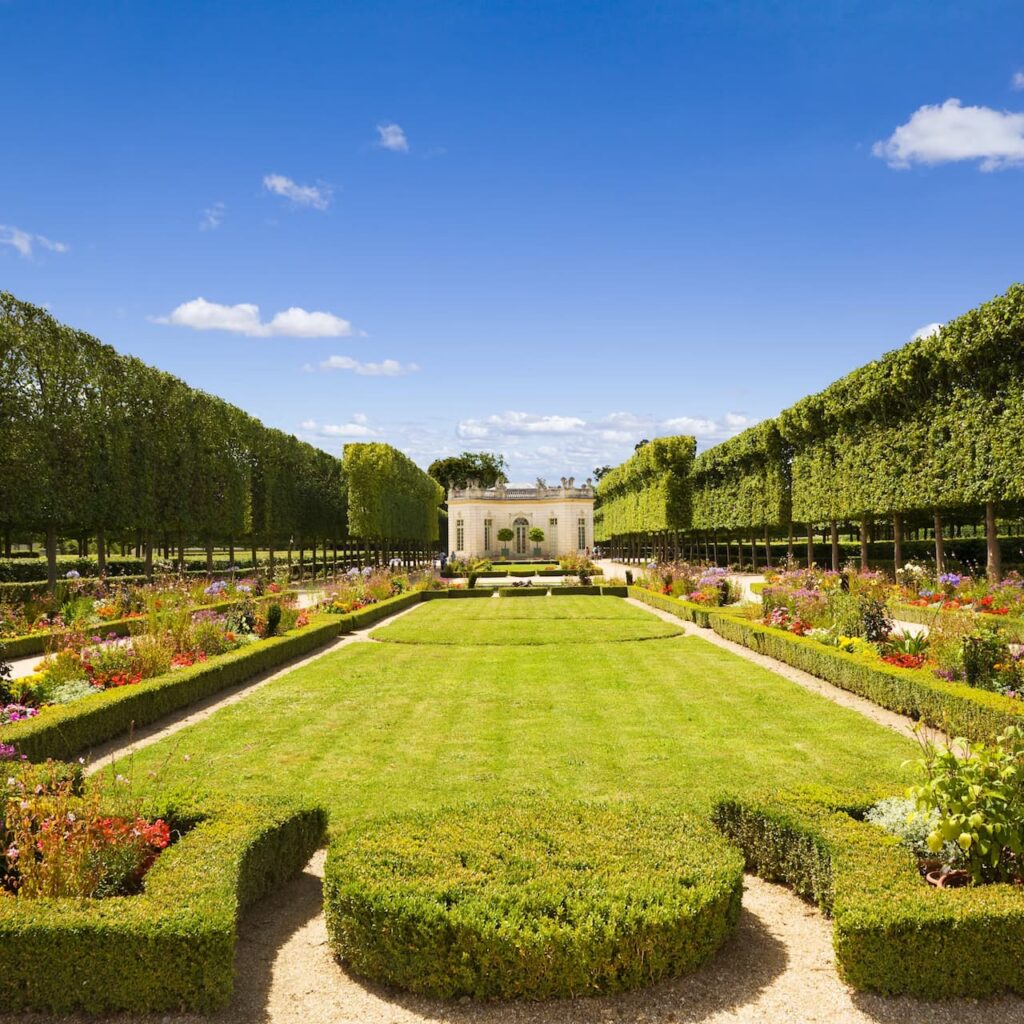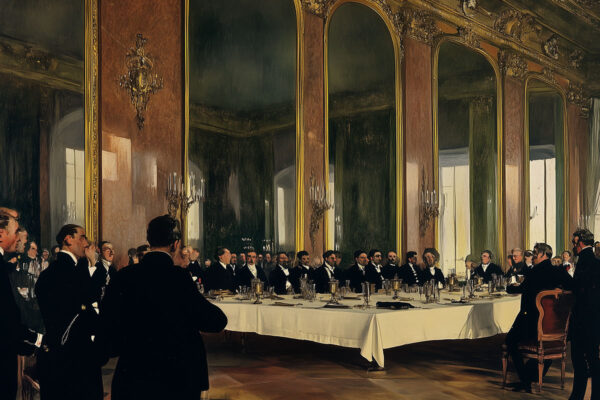If you are looking for information about the extraordinary history of the Palace of Versailles, you are just in the right place. Welcome to your virtual guide to discovering the magnificent Palace of the Sun King! This palace, a symbol of luxury and power, is a treasure trove of history, art and architecture.
In this article, I will take you on a fascinating journey through time to explore the history of the Palace of Versailles.
We will begin with a summary of Versailles’ origins, from its humble beginning as a hunting pavilion to its transformation into one of Europe’s most splendid royal residences under the reign of Louis XIV.
We will learn how Louis XIV decided to make Versailles the beating heart of his reign, moving the court there and undertaking a gigantic expansion and beautification project.
We will then continue with the history of the palace from the days of the monarch’s demise to the present day.
There will be no shortage of trivia about the construction of the palace. Did you know, for example, that tens of thousands of workers were employed to build this marvel? Or that Louis XIV had a river diverted to feed the spectacular fountains in the gardens? These and other anecdotes will make our tale even more compelling.
To answer all your questions, we have prepared a section of frequently asked questions, where you will find clear and precise answers about historical details and much more about Versailles.
So get ready to immerse yourself in the wonderful history of the Palace of Versailles. And if by the end of the article you are inspired to visit it in person, you will find all the information to buy tickets online and have an unforgettable experience. Ready to get going? Let’s get started!
ALT! Before we continue our journey to discover the history of the Palace of Versailles, stop for a moment! Do you know the secret to enjoying this marvel to the fullest without wasting time in line? Buy your tickets online now, this way you can enter the palace directly, avoiding long waits and spending more time discovering its extraordinary beauty. Don’t let the lines spoil your experience. Click here to book your tickets and ensure quick and stress-free entry to the Palace of Versailles!

Palace of Versailles: Entrance Ticket + Gardens and Trianon Estate
Buy online. Choose your preferred time. Visit the Palace of Versailles and the halls of the Palace, access the beautiful gardens and the stunning Trianon Estate.
You can cancel for free up to the day before your visit.
Table of Contents
The complete history of the Palace of Versailles
Origins and Louis XIII

In 1623, Louis XIII, suffering from agoraphobia and wishing to retire to a quiet place, decided to build a modest hunting pavilion at Versailles. Architect Nicolas Huaut designed this rustic structure, surrounded by moats and terraced gardens, which the king officially purchased on March 9, 1624.
This first château, known as “le chétif château” because of its modest size, became a seasonal retreat for Louis XIII and hosted special occasions such as Cardinal Richelieu’s secret visit in 1630, a major political event known as the “Journée des dupes” (Day of the duped).
Despite its simplicity, the chateau also occasionally welcomed the king’s mother, Marie de Medici, and his wife, Anne of Austria, although it did not yet have adequate apartments for them.
In 1632, Louis XIII finally purchased the domain of Versailles from Jean-François de Gondi, archbishop of Paris. Expansion work began under the direction of architect Philibert Le Roy, who added towers at the corners and replaced the wall with a six-arched portico.
The gardens were renovated in the French style, decorated with arabesques and interlacing. This second castle, known as the “Marble Court,” displayed more elaborate architecture than its predecessor.
In 1643, Louis XIII planned to retire to Versailles to devote himself to religion, but he died soon after, leaving the kingdom in the hands of his son Louis XIV, in turn under the regency of Anne of Austria. From that time on, the castle of Versailles was no longer a royal residence for eighteen years. But then
Louis XIV and the transformation into a palace
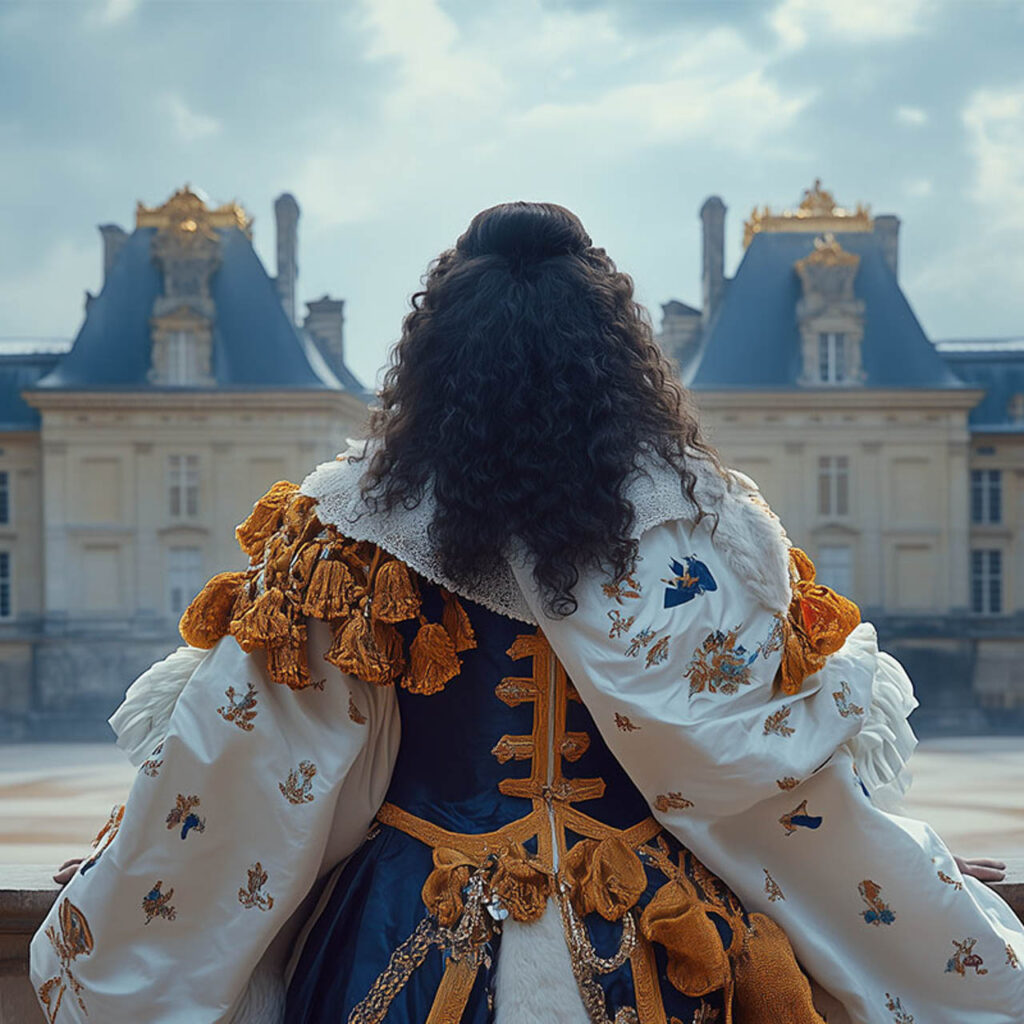
Early in his reign, Louis XIV could not find a suitable residence in Paris and experimented with various locations, including Vincennes, Saint-Germain-en-Laye, and Fontainebleau; all, in his opinion, with limitations. He therefore began to consider Versailles as an ideal solution.
In September 1660, he undertook a series of improvements to the château, appointing Jérôme Blouin to manage it and initiating work to enlarge the gardens. After his marriage to Marie-Thérèse of Spain, he visited Versailles and showed increasing interest in the estate.
In 1661, after the decision to rule independently without a prime minister, he began a vast project to expand the chateau, entrusting Louis Le Vau with its expansion and several artists with the decoration of the interior and the creation of the Orangerie and the Ménagerie royale. Despite criticism of the choice of Versailles as the royal seat, Louis XIV persisted with the work.
First construction campaign (1661-1668)
In 1664, Louis XIV organized the feast “Les plaisirs de l’Île enchantée” at Versailles, inspired by Italian epic poems and Molière’s plays, to celebrate Mademoiselle de La Vallière. During the event, many courtiers, unable to find lodging in the chateau, had to stay in nearby inns, prompting the king to seriously consider an expansion of the structure.
On Colbert’s advice, he therefore chose to include Louis XIII’s small castle in the renovation plans. Louis XIV also wished to house his ministers at Versailles and commissioned Le Vau to build wings devoted to government affairs, which were completed in 1666. The gardens were enlarged and decorated with sculptures. In 1667 the Grand Canal was excavated.
After a military victory, the king organized the “Grand Divertissement Royal de Versailles,” introducing his new mistress, Madame de Montespan. The festivities, however, highlighted the inadequacy of the small castle, prompting the king to plan further expansion. Although Le Vau proposed demolishing the existing castle, Louis XIV insisted on preserving it, leading to the conception of the Enveloppe project.
Second construction campaign (1669-1672)
During the second building campaign at Versailles, the so-called Enveloppe, a second circular building around the existing chateau, was developed, designed between 1668 and 1672. This new symmetrical structure housed the King and Queen’s apartments, adorned with marble, gilded wrought iron, and balconies.
The roofs were refinished and the courtyard paved with marble. The new buildings tripled the area of the chateau, and Jules Hardouin-Mansart, who succeeded François d’Orbay, became the principal architect, realizing an even grander vision.
The new chateau, of Italian design, was built entirely of stone, with avant-corps interrupting its facades. The west facade featured a large terrace separating the King’s and Queen’s apartments. The ground floor was lit by centered windows overlooking the gardens, while the main floor displayed a sequence of niches, Ionic columns, and rectangular windows. On the second floor, the Corinthian order was enhanced by a balustrade with trophies and lanterns.
In 1670, Louis XIV decided to demolish the village of Trianon, northwest of the park of Versailles, to build the Trianon de porcelaine, clad in Delft porcelain. Around it, courtiers built their own residences to be close to the king, resulting in 14 grands hôtels between 1670 and 1671.
Versailles, initially just a pleasure residence, became the emblem of the political and economic project of absolute monarchy, with the king at the center of administration and court.
Third building campaign (1678-1684)
The third building campaign at Versailles, initiated after the signing of the Peace of Nijmegen that ended the Dutch War, marked a significant transformation of the chateau. Under the direction of Jules Hardouin-Mansart, the palace’s current appearance took shape. The Gallery of Mirrors, along with the Salons of War and Peace, became thehallmark of this new phase, while work in the gardens marked the rest of Louis XIV’s reign.
As the work progressed, the palace also needed a suitable green setting. The gardens of Versailles became one of the grandest examples of the French Baroque garden. In 1682, Louis XIV decided to permanently move the court to Versailles, although work was still in progress and there were problems with the accommodation of courtiers.
The court at Versailles represented the pinnacle of aristocratic society, turning the nobles into supporters of the state and the king. Louis XIV established strict rules of etiquette governing every aspect of court life, creating sacralized ceremonials around his daily actions.

ID 47105909 @ Gaspard Walter | Dreamstime.com
The Gallery of Mirrors, built between 1678 and 1684, represented one of the highlights of the third building campaign. This long corridor, adorned with mirrors and Rococo decoration, connected the King’s and Queen’s apartments, serving as a spectacular passageway between the different residences. The Palace of Versailles, with its gardens and sumptuous rooms, became a model for the courts of Europe, a symbol of the power and magnificence of the Sun King.
Over the years, new additions and refinements further transformed the palace. The construction of theOrangery, stables, the “Grand Commun,” and the north and south wings extended the facade of the chateau and increased its overall grandeur.
In 1686, the decoration of the Gallery of Mirrors was completed, and was immediately followed by important events such as the reception of ambassadors from the King of Siam in 1686 and Louis XIV’s decision to replace the porcelain Trianon with the Grand Trianon in 1687.
Versailles was not just a royal residence but an entire city in expansion, with courtiers building their own residences, taverns and hotels enlivening the streets, and a population that reached 70,000 on the eve of the Revolution. The palace remained the center of French power and culture until the end of Louis XIV’s reign, continuing to exert a strong influence on continental Europe.
Fourth construction campaign (1685-1710)
The Fourth Building Campaign at Versailles, launched between 1699 and 1710, was the last building effort undertaken by Louis XIV before his defeat in the War of the League of Augsburg. His last major work was the construction of the Versailles Chapel, designed by Jules Hardouin-Mansart and completed in 1710 by Robert de Cotte. With the completion of the chapel, the period of building Versailles under the Sun King can be considered concluded, with further work only resuming during the reign of Louis XV.
The year of Louis XIV’s death, 1715, was marked by a significant event at Versailles: the reception of the Persian embassy. This was the last public occasion organized by the Sun King, as if he wanted to end his reign on the Versailles stage. Louis XIV received the Persian ambassadors in the sumptuous Gallery of Mirrors, impressing the guests to the point that they were granted a second audience for the signing of a treaty of commerce and friendship between France and Persia.
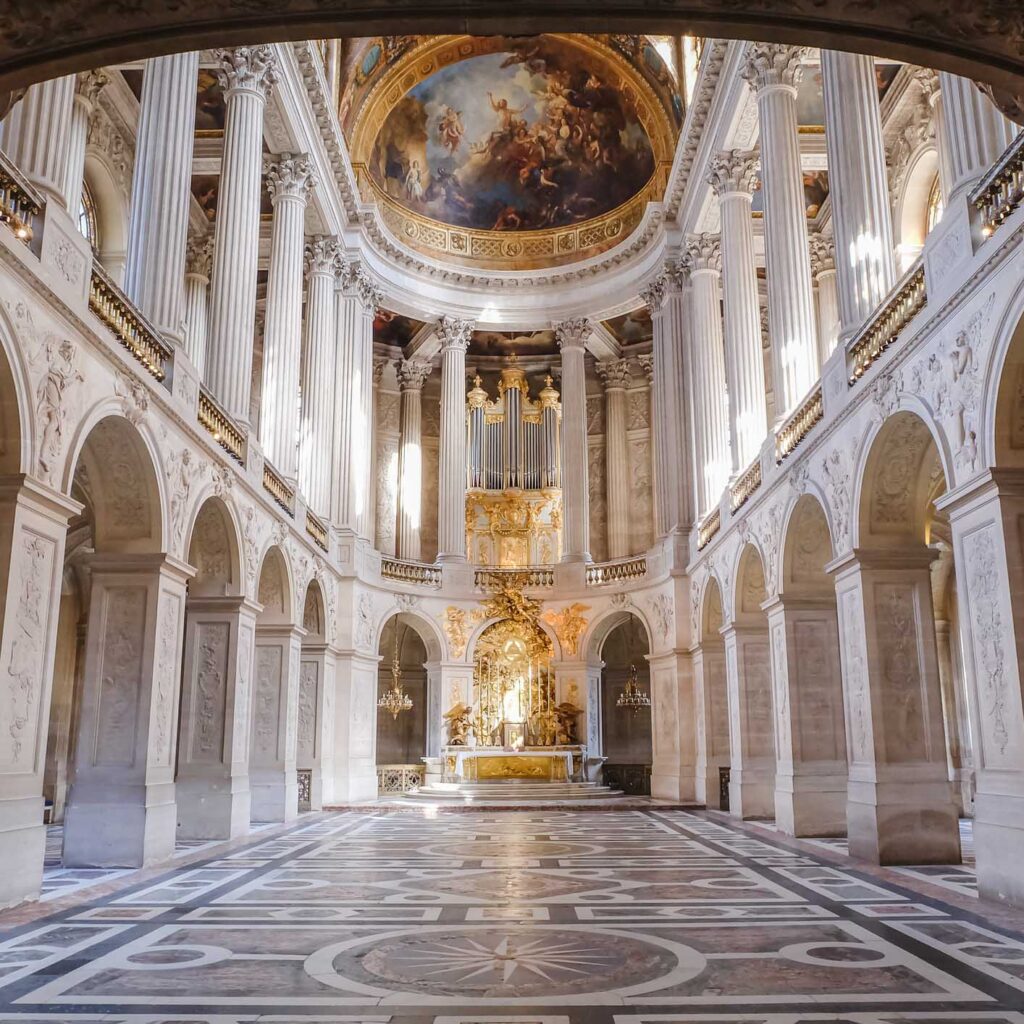
ID 223178687 @ Peerapat Lekkla | Dreamstime.com
The death of Louis XIV on September 1, 1715, marked the end of the Great Century, so named by Voltaire in honor of Louis the Great. With 77 years of age and 72 years and 100 days of reign over France, the Sun King left behind a monumental legacy, embodied in the magnificence of Versailles.
Versailles after Louis XIV
Louis XV ascended the throne in 1715, but as he was still a child, his guardian Philip of Orleans moved to Paris and the court moved temporarily to the Tuileries. During the regency, the Duke of Noailles even proposed the demolition of the Château de Versailles.
In 1722, at the age of 12, Louis XV returned to Versailles and settled in the apartments of Louis XIV, trying to maintain the traditions of the place. However, unlike his predecessor, Louis XV showed no particular affection for Versailles; in fact, he preferred to spend his time elsewhere. Transformations during his reign included the demolition of parts of the chateau and the construction of new structures such as the Petit Trianon, the Hercules Hall, and the Opéra.
During the reign of Louis XVI, however, court life at Versailles began to lose its former splendor, with courtiers and the royal family fleeing, and the apartments lacking comfort and heating. The king attempted to restore the palace, wanting to make Versailles more comfortable and modern, despite limited financial resources. This led to modest interventions, such as the decoration of the woodwork and the purchase of furniture from the factories of Gobelin and Lyon.
Queen Marie Antoinette, at the Petit Trianon, built theHameau, a village where she could escape court etiquette and live a simpler life with her children. She also loved the gardens and plants of the Palace, finding in them a refuge from her husband’s isolation and neglect, and preferring a bucolic and playful life with her closest friends.
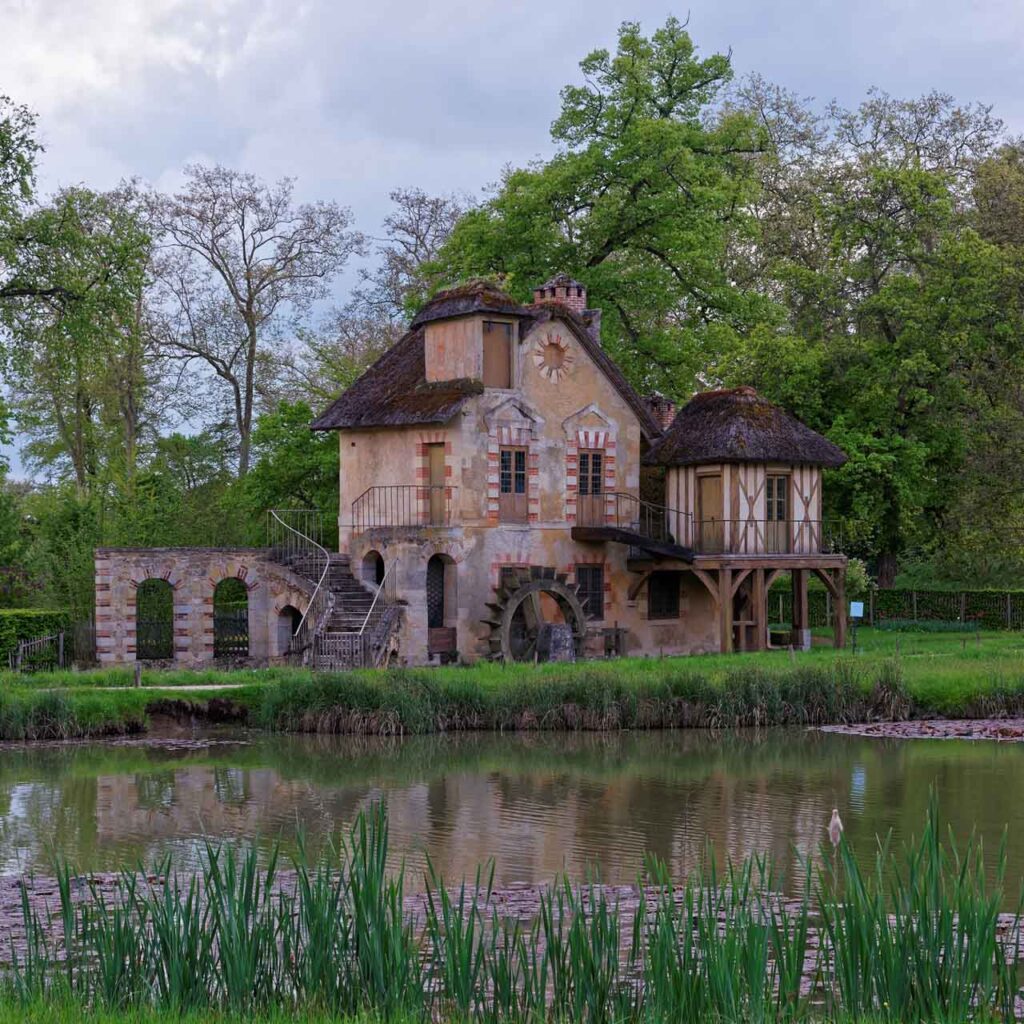
ID 81170951 @ Erix2005 | Dreamstime.com
Louis XVI, upon his accession to the throne in 1774, had a library built for his personal needs, decorated by Ange-Jacques Gabriel and Jules-Antoine Rousseau, with a table specially made to display his Sèvres porcelain. In this library, in 1785, the king ordered the arrest of his great almoner.
In 1783, the Cabinet doré, originally attached to Madame Adelaide’s apartments and transformed into an exhibition room for Louis XIV’s collection of gold crockery, was built. Under Louis XVI, it became a museum environment, a place to display the king’s personal collection, including his assortment of butterflies.
The French Revolution and the decline of the Palace
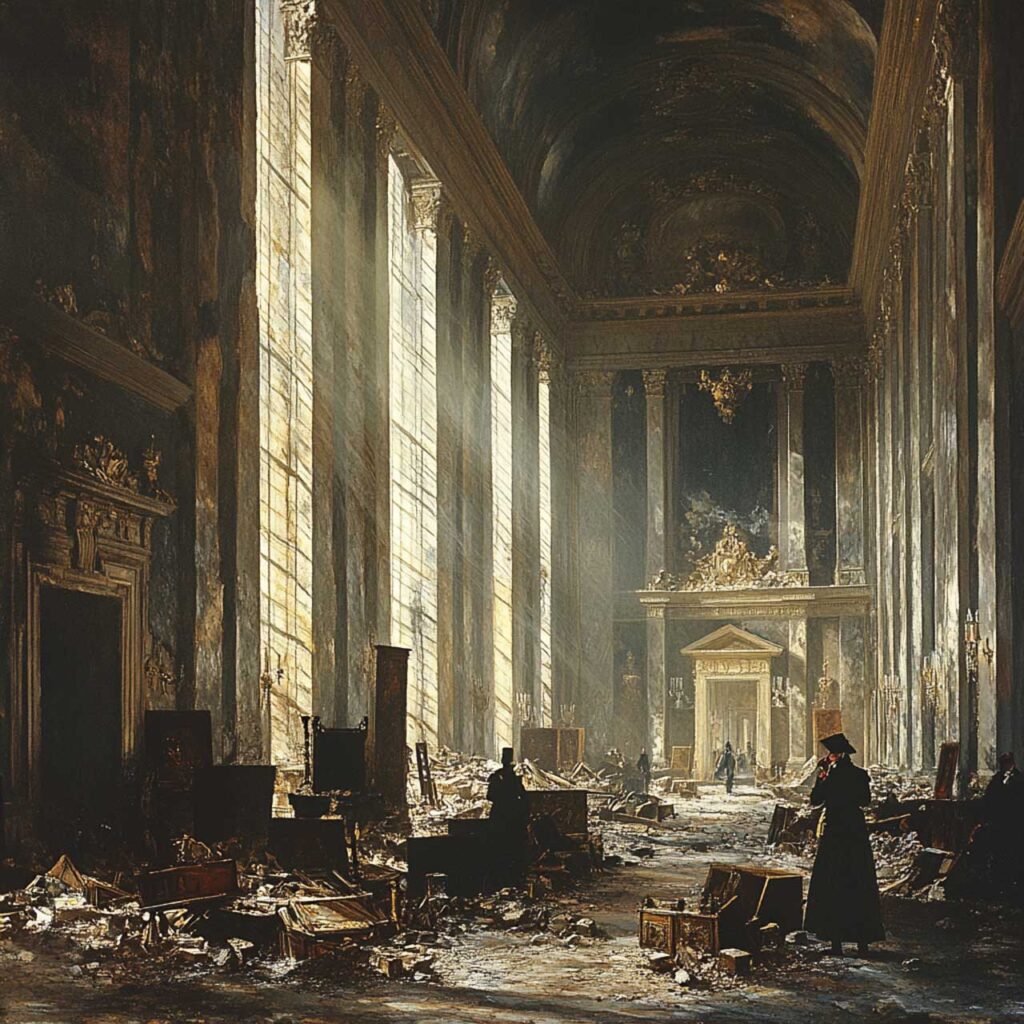
Versailles, a symbol of French monarchical power, was the scene of its rise and fall during the Revolution. The States General of 1789 marked the beginning of the decline, followed by the transfer of the court to Paris in 1789.
In 1791, the symbols of the monarchy were removed, and in 1792 the palace was looted. After the execution of Louis XVI in 1793, the furniture of Versailles was auctioned off and many ended up in England to furnish royal residences.
Charles-François Delacroix proposed demolishing the palace to make farmland, but the idea was discarded as impractical. Instead, the revolutionaries transformed the gardens for agricultural purposes, and places like the Petit Trianon became revolutionary haunts.
Versailles, once a symbol of royal power, suffered the reverse of history, witnessing the collapse of the French monarchy.
Versailles in the 19th Century

Napoleon Bonaparte, in 1804, officially took possession of the Palace of Versailles through his grand marshal of the palace. Although the complex was still standing, it was completely empty. In 1805, Pope Pius VII delivered an Angelus at Versailles during Napoleon’s coronation in Paris.
The palace remained unused until the return of the monarchy. Napoleon planned to turn the Grand Trianon into his summer residence, but more ambitious plans to transform Versailles were interrupted by war expenses.
In 1810, after his marriage to Marie Louise of Habsburg-Lorraine, he resumed the idea of transforming Versailles, but only the Grand Canal was restored.
The Bourbon Restoration in 1815 saw Louis XVIII initiate restoration work, but he did not move there permanently. Instead, Louis Philippe I decided to transform Versailles into a national museum of French history. Indeed, the Galerie des Batailles, completed in 1837, was intended to celebrate France’s military victories.
During the Second Empire, Napoleon III helped preserve the chateau but did not undertake any major transformation projects.
Pierre de Nolhac, appointed curator of the museum in 1892, began an ambitious program of restoration and redevelopment. His revolution in restoration brought new life to Versailles, attracting influential donors and leading to the creation of the Society of Friends of Versailles in 1907.
The 20th Century and the Preservation of the Palace
In 1919, the Treaty of Versailles was signed in the Mirror Gallery, a symbol of France’s victory. However, the gardens were still severely neglected. It was John D. Rockefeller who financed its restoration a few years later, also prompting the French government to allocate an annual budget for the chateau.
During World War II, Pierre Ladoue, inspector general of fine arts, saved many works by moving them elsewhere. Even with the Nazi presence in Versailles, the chateau remained almost empty. After the war, the works were returned to the premises and restoration work resumed.
From 1951, Charles Mauricheau-Beaupré, conservator of the Versailles complex, drew attention to the castle’s deterioration. In 1952, he asked for help from the people of France to save Versailles, obtaining funds from the Bank of France and the population, as well as support from artists such as Henri Matisse and Jean Cocteau. The collaboration carried on the restoration work, keeping the cultural heritage of Versailles alive.
Versailles today
Versailles later returned under the control of the French president to welcome visiting foreign heads of state, including John Kennedy, Elizabeth II, Shah Mohammad Reza Pahlavi, Mikhaïl Gorbatchev and Boris Yeltsin.
General De Gaulle ordered the renovation of the Grand Trianon to accommodate heads of state, reserving a wing for the president as well. In 1999, it came back under the control of the chateau. The Pavillon de la Lanterne became a secondary presidential residence in 2007 under Sarkozy.
Versailles was also the target of an attack in 1978 by Breton nationalists, who damaged several rooms with a bomb.
After the Third Republic, Versailles housed the French Parliament Congress, with thirty apartments occupying 7,000 m² in the South Wing.
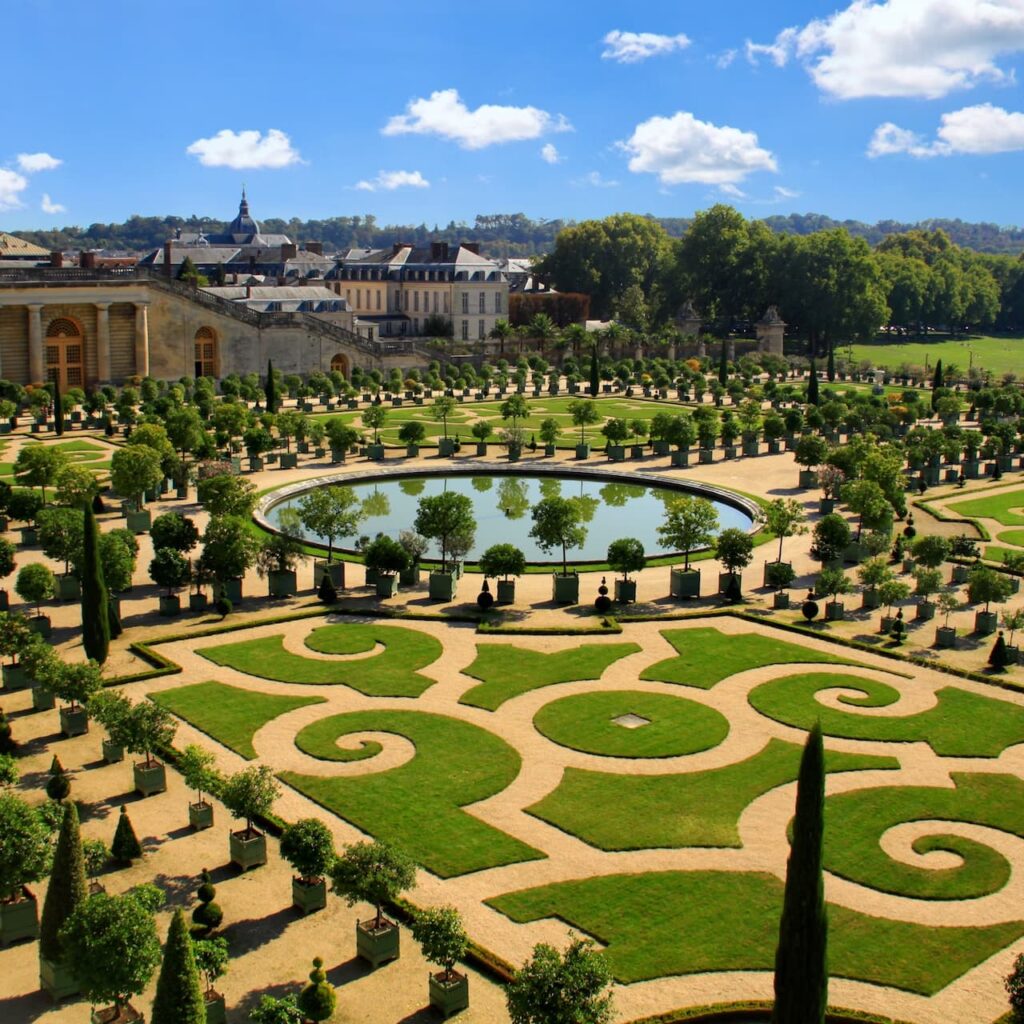
Palace of Versailles: Entrance ticket + Gardens and Trianon Estate
Purchase online. Choose your preferred time. Visit the Palace of Versailles and the halls of the Palace, access the beautiful gardens and the stunning Trianon Estate.
You can cancel for free up to the day before your visit.
5 interesting facts about the construction of the Palace
The history of the Palace of Versailles is shrouded in a unique fascination of court intrigue, royal pageantry and architectural curiosities. Behind the sumptuous facades and majestic gardens lie fascinating stories that reveal the ingenuity and vision of its creators.
In addition to its intrinsic beauty, the Palace of Versailles is also impressive for its sheer size. Every aspect of the palace is characterized by its mammoth size and astounding figures.
Thousands of arms
During the construction of the Palace of Versailles, thousands of laborers worked tirelessly under the strict control of the royal architects. It is estimated that up to 36,000 workers contributed to the construction of the palace, with tasks ranging from laying foundations to decorating the interior.
Dominion over nature
A fascinating anecdote concerns the detour of the Eure River to feed the majestic water features in the gardens of Versailles. This titanic work required the construction of a complex system of canals and dams to direct the river’s waters to the lakes and fountains of the gardens, adding an element of technological grandeur to the architectural magnificence of the palace.
Problems of space
With some 700 rooms, 67 staircases, hundreds of fireplaces and more than a thousand service rooms, the palace is a veritable labyrinth of luxury and grandeur. Its gardens cover an area of more than 800 hectares, with nearly 200,000 trees and hundreds of thousands of flowers planted annually.
Thirsty, anyone?
The fountains of Versailles, with their intricate water features and majestic sculptures, required a complex hydraulic system consisting of 35 kilometers of piping, 221 fountains and 1,252 water jets. During grand court festivities, between three and six thousand kiloliters of water were used to feed the fountains, creating an unprecedented spectacle.
A matter of budget
The financial figures are also impressive: it is estimated that the construction and maintenance of the palace required a total expenditure of more than 2 to 3 billion euros (in today’s currency), making Versailles one of the most expensive royal residences ever built.
Frequently asked questions about the history of Versailles
The Palace of Versailles was built primarily as a symbol of power and magnificence of the French monarchy.
It was commissioned by Louis XIV to serve as a royal residence and the center of France’s political and cultural power.
Its construction was also aimed at consolidating the king’s control over the nobility by providing a lavish court environment that drew the aristocrats’ attention and adherence to his person.
The Palace of Versailles was inhabited by the French royal family, including the king, queen and their children.
In addition to the royal family, the court included nobles, courtiers, ministers and other members of the aristocracy.
The palace also housed a large circle of servants and staff who managed the daily activities of the palace.
A variety of activities related to court life and royal ceremonial took place in the court of Versailles. These included receptions, feasts, balls, plays, concerts, religious ceremonies, political and diplomatic meetings, as well as entertainment activities such as hunting and outdoor games.
The court at Versailles was also the center of France’s political and administrative power, where matters of state were discussed and important decisions were made.
The Palace of Versailles is considered the symbol of absolutism for several reasons. First of all, it was built by Louis XIV, the “Sun King,” whose reign is often associated with the height of monarchical absolutism in France.
The palace itself was designed to express the king’s power and grandeur, with its imposing size, opulent interiors, and lush landscaped gardens. In addition, Versailles was the center of France’s political and administrative power, where the king exercised his control over nobles, courtiers and state officials.
The court ceremonial and strict rules of etiquette that reigned at Versailles emphasized the king’s sovereign position and unchallenged authority.
Finally, the construction and furnishing of Versailles was financed through exorbitant taxes and forced labor, further emphasizing the king’s absolute rule over his nation.
Conclusions
Well, we have come to the conclusion of this journey through the history and curiosities surrounding the majestic Palace of Versailles.
We have explored its history, from its founding under Louis XIV to its significant role in later centuries. Through the centuries, Versailles has been more than just a royal residence; it has been the hub of political power, the stage for crucial historical events, and the symbol of monarchical absolutism.
We also took a close look at trivia about the construction of this magnificent palace, uncovering the intricate details of its design and the stories behind its creation.
Finally, we addressed a series of frequently asked questions, providing a comprehensive overview of the people who lived at Versailles, the activities carried out in its court, and its significance as a symbol of absolutism.
The Palace of Versailles remains a living testament to the grandeur and complexity of French history. It continues to enchant and inspire visitors from around the world with its timeless beauty and rich cultural heritage.
If you still have questions or curiosity about the Palace of Versailles, please feel free to leave a comment below.
If, on the other hand, you are ready to immerse yourself in its magnificence in person, don’t miss the opportunity to purchase your entrance tickets or book a guided tour directly here.
